Introduction
The Military Memorial of Pocol of Cortina d'Ampezzo is a monument to the memory of the fallen of the First World War. Here rest the remains of over 10,554 Italians who died on the dolomitic Front. It is not much considered by tourists, although it certainly deserves a visit. It has a particular charm and evokes deep and melancholic thoughts.
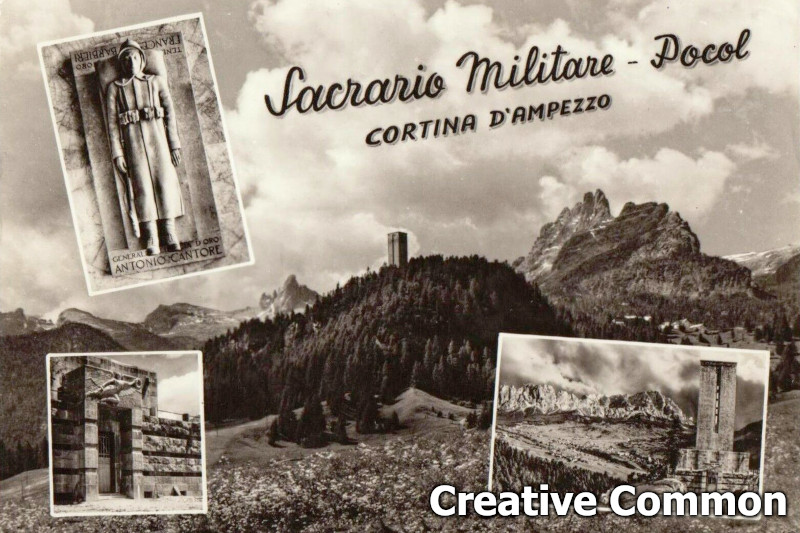

The history of the sanctuary
The Pocol military shrine was inaugurated in 1939, the works began in 1932 and were completed in 1935. The building is based on a project by the engineer Giovanni Raimondi. The ossuary looks like a massive vaguely orange tower, forty eight meters high, one hundred and fifty feet, clearly visible from almost every point of Cortina.

The tower has a two-level base, which encloses the actual shrine. The style is that of the time, a rationalist architecture typical of the fascist period. This is the most massive military memorial in the Dolomites.
... it was erected over the Eagle Cemetery....
The tower was erected on the top of Mount "Crepa," 1,535 meters above sea level, near the "Belvedere" of Pocol. Here there was a pre-existing cemetery known as the Cemetery of the Eagles. It was a burial place built in 1915 to house the bodies of those who died during the advance on the dolomitic Front.
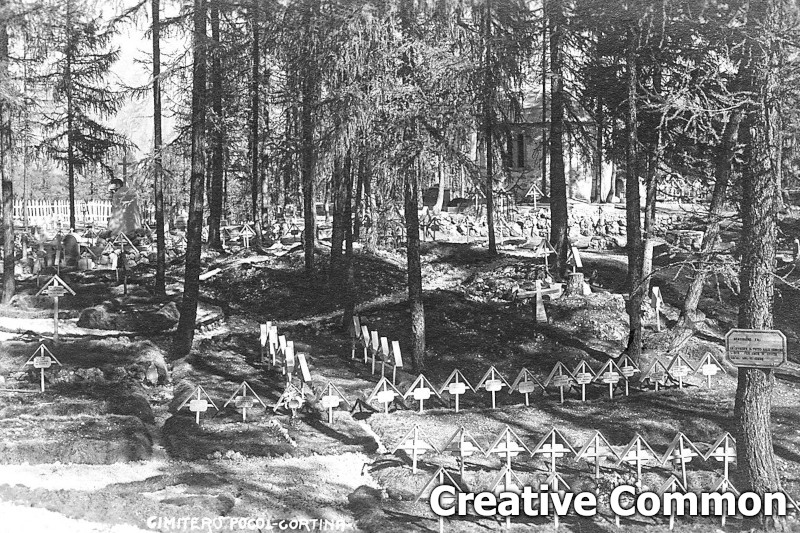
Once the construction was completed, the bodies of the soldiers were transferred from the Cemetery of the Eagles to the new ossuary, in addition to the remains of known and unknown Italian fallen soldiers, from various war cemeteries in Cadore and Ampezzo. Teams of militarized workers were in charge of the operation, with the assistance of a military chaplain.
According to some sources, not all the population was happy to move the fallen from their resting place. Great thinkers, such as Paolo Monelli and Dino Buzzati tried to defend the peace of the former comrades, without achieving much.
... the conditions of the military cemeteries were not optimal...
It's important to report that, reading the municipal reports of the time, the conditions of the military cemeteries were not optimal and it was often pointed out that many repairs and maintenance were needed. Probably this was considered the best solution, which could give the most dignified burial to the fallen for many years to come.
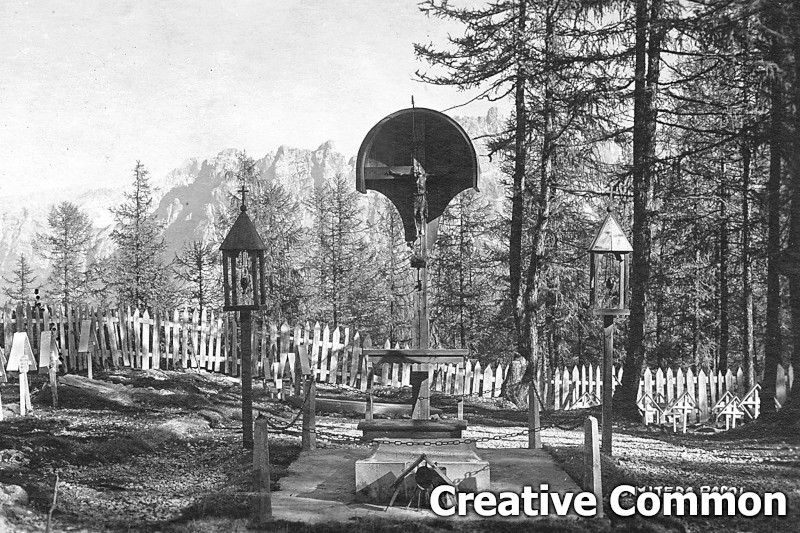
The cemetery was served by a small chapel, built in 1916 by the Alpine soldiers of the 5th Group, whose bell still rings once a year on the anniversary of the end of the Great War for Italy, November 4.
Inside the small church, above the front door, there is a fresco by Pio Solero that depicts a dramatic scene of an Alpine soldier in the snow, as he watches over a fallen comrade in arms.
... they shone like stars and faded into infinity...
In the image below you can see the entrance of the former cemetery. The phrase clearly visible at the entrance was really touching, it means: "they shone like stars and faded into infinity."

At the inauguration, presided over by a military chaplain, were present the Undersecretary De Marsanich, His Royal Highness the Duke of Pistoia, the son of General Cantore and the mother of Lieutenant Barbieri.
... the total number of bodies is 10,554...
Originally, the remains of 9,707 fallen Italians were kept inside the shrine, of which 4,455 remained unknown. Here lies also 37 fallen known Austro-Hungarians, from the nearby war cemeteries of Brunico and San Candido.
In the years following the inauguration the remains of many other soldiers resurfaced in the mountains and was taken to the Pocol ossuary. At the end of 2010, the total number of bodies had risen to 10,554.

Visit to the ossuary
Once you park your car in the large parking lot, enter through the walls. There you will find a slope surrounded with stone works dedicated to the fallen. There is also a sign that asks to respect the site. The sculptures representing the army corps known as "Alpini," the Italian mountain infantry, are copies of the one that can be seen in the center of Cortina, on the memorial to General Cantore, near the bus station.
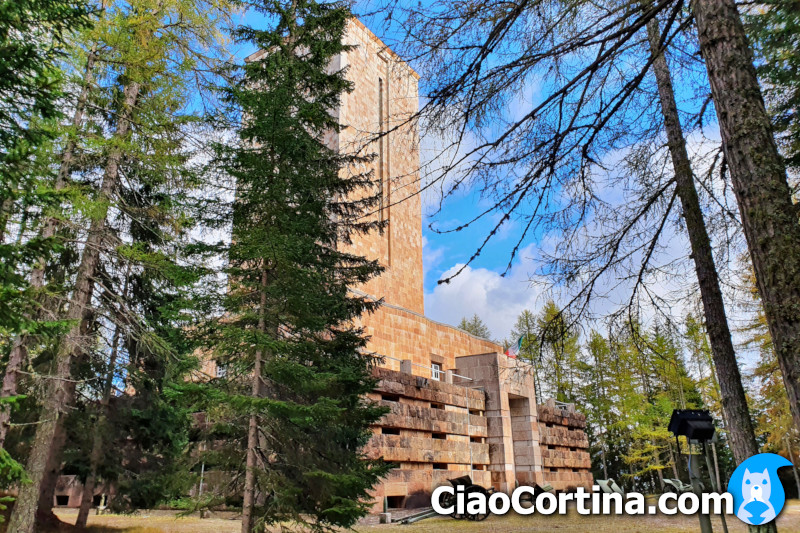
Once you reach the top of the slope, you will be greeted by a statue of the Leon of St. Mark. The statue was originally part of a fountain, located in "Piazza Venezia," in the center of the town. The lion was built by the chief magistrate of Cortina, in 1936, to commemorate the days when Ampezzo was part of the Republic of Venice, at a time in history when nationalism was very strong. In the 1960s the fountain was demolished and the lion statue moved to Pocol.
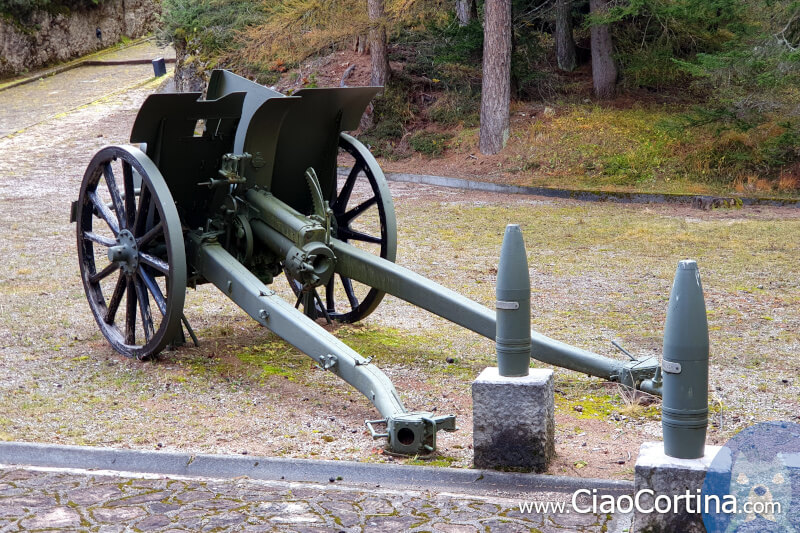
Now cross the two cannons to reach the access steps, carved into the rock. Descend down the ramp, you will be surrounded by bronze tablets of the "Via Crucis" made by Giannino Castiglioni. Once you reach the main forecourt, you'll see other war relics and the entrance to the shrine. If you turn left, going a bit into the woods, you will find the small church of the Cemetery of the Eagles, which we mentioned earlier.
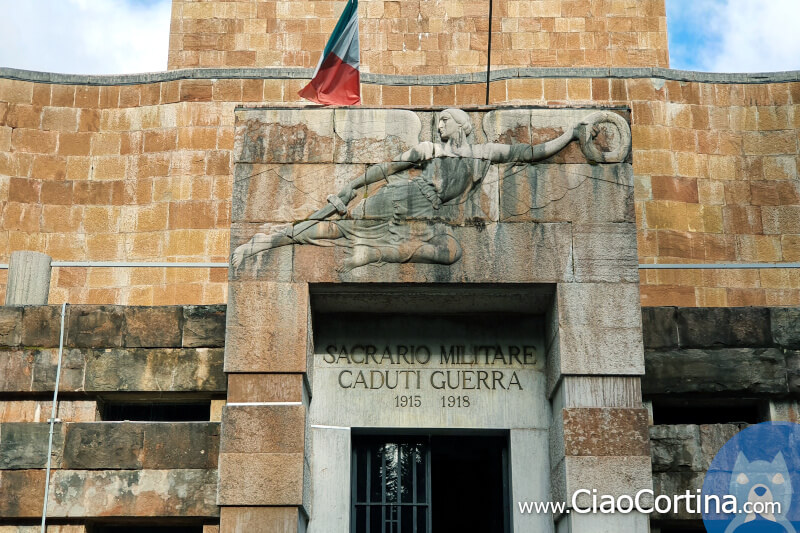
Once you have visited the forecourt, head to the entrance to the sanctuary, bordered by two pieces of artillery. Crossing the main door, you will see a very austere environment, in line with the spirit of the place. In the crypt in the center of the tower there is a large gravestone, depicting the Dead Infantryman. Inside the gravestone rests in peace the remains of General Antonio Cantore and Lieutenant Francesco Barbieri, while the remains of the other fallen are collected in niches arranged along the internal walls of the corridors.

Going up to the next floor it is possible to see the graves of Riccardo Bajardi and Mario Fusetti, as well as to have a different perspective on the statue of the dead infantryman. Unfortunately, it is not possible to climb to the top of the tower, from which one would see a beautiful view of Cortina, but after all, it is understandable: it is not a place of recreation.
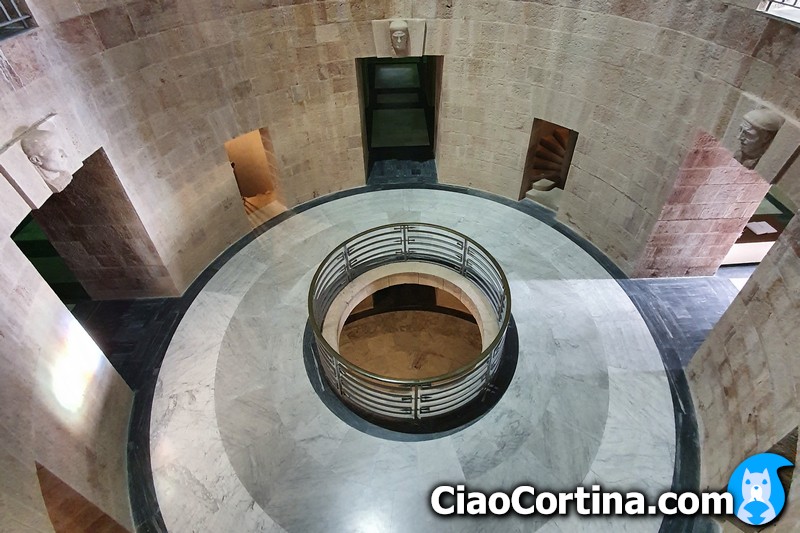
Once back in the main hall you have seen everything, so you can leave. The visit to the ossuary house ends here, it's up to you to decide if you prefer to walk around or return to your car.

How to reach it
The Military memorial of Pocol is open on working days, excluding Mondays, from 9 a.m. to 12 p.m. and from 2 p.m. to 5 p.m.
It can be easily reached by car, following the signs towards Giau Pass and Falzarego Pass. When you see the forest open up, you will pass two narrow hairpin bends, then you will see a large hotel. Just before the hotel, you will have to take the little road on the right. In any case, it's easier if you click on the name a few lines above, it will open Google Maps, then you can use the navigator.
Another option is to take the bus, line 30-31 to Falzarego Pass and get off at the stop at Pocol. It is a seasonal bus that's active from mid-June to mid-September. For more information and to purchase tickets, you should contact the ticket office at the bus station. It may be closed during lunch hours.
Finally, you could consider taking a taxi. From Cortina to the Military Memorial the cost should be, approximately, €30. Consider that prices could vary greatly, both for the type of vehicle and the number of people, so you should ask for a quote. Taxis are found both in Roma Square and the bus station, or you can visit the official taxi website.
For any doubts you may have, you can consult the Tourist Information office in the center of Cortina.
Self-reflection
Walking through this place, and looking at the countless headstones, the thought of how many young lives left us in these mountains is heartbreaking. It is a place that can make you contemplate the horrors of war more than all the photographs in the history books.
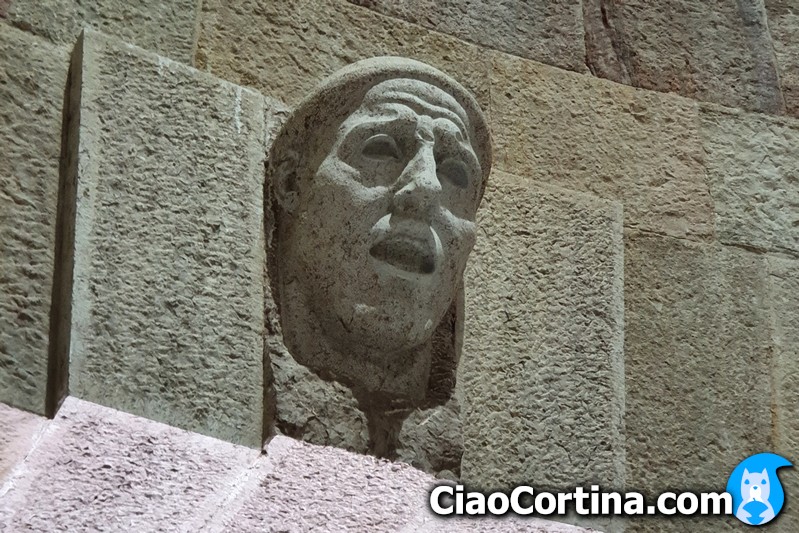
Reading the impressive number of names written on the walls, considering that most of the bodies do not even have names, is overwhelming. Personally, we consider the Pocol Ossuary to be the place where the mourning and suffering that the war brought to the Dolomites is most deeply felt.
Obviously this is not a place for family recreation, but a memorial cemetery, so the environment is austere and invites reflection on the extreme sacrifice that the soldiers made for their homeland, fighting in inhumane conditions on the trenches in the Dolomites.
Curiosity
We want to leave you with a curiosity. Every year, in Italy, there is the "Sunday of the Dead," which the rest of the world knows as Halloween. It is a week in commemoration of the dearly departed. During this week, at Pocol, a mass is celebrated in memory of all the fallen.
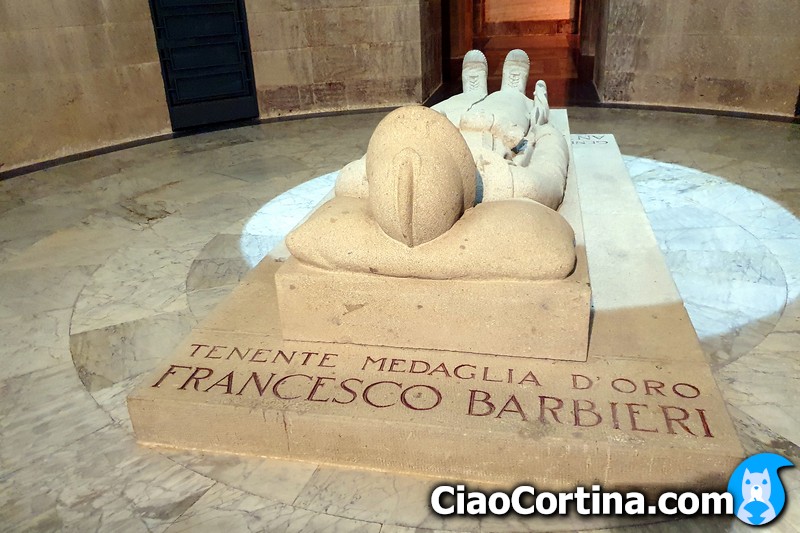
To commemorate this event, during the week preceding the commemoration of all the faithful dead, a large cross is lit on the facade from the military shrine, it is clearly visible from anywhere in the town.
Considering the historical significance of these days, some Italians are not happy with the Halloween happiness culture coming from USA to Italy in the last few years.

Conclusion
We hope you liked this page on the Military Memorial of Pocol. Before saying goodbye, we would suggest you read our home page, with all the articles we wrote about Cortina d'Ampezzo.
If you want to thank us you can read the page Support us. If you only want to suggest a change, propose something or just say hello, in the section contacts and info you'll find all the ways to reach us.